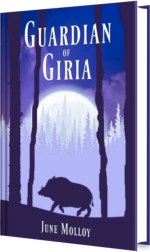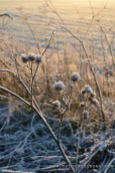Chalky Cellars at Taittinger

22 million. That’s how many bottles of champagne Taittinger have ageing in their cellars at any one time. Unlike wine, all champagne is aged in the bottle it will eventually be sold in. Taittinger produce a variety of bottle sizes, but mostly they stock the regular 750ml bottle and the double-size (1.5 litre) Magnum bottle – larger bottles generally have to be ordered in advance. And given the ageing period – a minimum of three years – they would need to be ordered quite some time in advance.
Champagne is an elitist product and there is an air of this elitism as you walk into the Taittinger cellars in Reims. The receptionists and tour guides are beautiful and impeccably groomed. The walls and floors are white and spotless. The crystal cabinets set into the wall display the Taittinger art-deco collection – bottle paintings created by some of France’s most prestigious young artists.

A selection of the art deco bottles at Taittinger.
The tour begins with a video on the history of both champagne and the Taittinger brand, after which we descend into the chilly cellars. The cellars range in temperature from 10-12 degrees, depending on how deep you go down. The cellar temperature is maintained by thick chalk walls, a feature of the Champagne region. In fact, this chalk is what makes champagne different from other wines – the chalky soils of the region create the ideal growing conditions for the grapes. Only grapes grown on this soil & within the designated Champagne region can be used to make champagne.


A selection of Champagne bottle sizes.
Unlike most French wine, grapes for champagne are not grown on estates owned by the champagne houses. Instead, the grapes are grown on individual, privately owned vineyards and bought by the champagne houses, who then produce the champagne. (Some small vineyards are now producing their own champagne, but given the production costs this is quite limited and does not include the big-name brands.) The same vineyard could produce grapes for a number of different champagne houses on neighbouring strips of land. Grapes from different years can be mixed to create the perfect blend.
This is very different from the “Chateau” system that operates throughout the rest of France, where only grapes grown on the Chateau’s own vineyard are used in their wines and only grapes from a single year are used in any one wine. Only in occasional years (perhaps twice per decade) will a champagne house decide that the grapes are sufficiently exceptional to warrant a “vintage” champagne, which will then contain only grapes from that individual year.

Despite the thick glass, some bottles still explode from the force of the bubbles!
The reason for ageing the wine in the bottles is to create the distinctive champagne bubbles. The champagne is only partly fermented before being bottled. Extra sugar and yeast are added at bottling and further fermentation takes place within the bottle. Because the bottle is sealed, the carbon dioxide produced by the fermentation cannot escape and so the bubbles are created.

The light highlights the sediment in the bottom of the bottle.

A-frame Riddling Rack (Pupitre)

Riddler (Remueur) at Work.
There are 3 million bottles of champagne in the Taittinger cellars in Reims. (The other 19 million are stored elsewhere.) It’s quite an amazing sight – the stacks of bottles seem never-ending. It’s also amazing that these dusty bottles will end up on shelves around the world. Having aged for anything from 3 to 9 years, the bottles are “riddled” for 10 weeks – a process by which the bottles are slowly changed from their horizontal ageing position to an upside-down vertical position in order to move the sediment to the bottle opening so that it can be removed.
The bottles are slowly rotated manually by a Riddler (Remueur) as the angle changes so that all sediment is gently moved to the opening without disturbing the wine. The tops of the bottles are then frozen at -25 degrees for 10 minutes. When the metal cap is removed, an ice-cube containing the sediment shoots out of the bottle under pressure from the carbon dioxide within. The displaced liquid, about 20 ml, is then replaced with champagne and some additional sugar. The amount of sugar added depends on the style of champagne being produced – brut (dry), semi-dry or sweet.

The obligatory tasting at the end of the tour!
Our tour ends with a tasting of the brut champagne. I had the misfortune of being part of a tour group that was very international and not really inclined to mix and, as my husband had declined to join me on the tour (due to absolute lack of interest), I was sampling tout seul. For me, champagne drinking is a convivial affair and drinking it alone is not much fun. Nonetheless, I preserved in the name of research. It was perfectly pleasant – dry, but not too acidic, with a hint of the buttery notes typical of champagne. But despite being one of James Bond’s favourite brands of champagne*, I’m afraid I wasn’t blown away. Perhaps it was my lack of company or my mood – if I had been drinking this at some joyous family celebration, or perhaps on a sunny terrace in Cornwall, it may have tasted more “special”.
* Taittinger Champagne is featured in a number of the Ian Fleming’s James Bond novels and in one of the movies. However, for reasons not fully understood, but most likely marketing related, Bollinger took over as James’s favourite tipple in the later movies.

The palatial residence at Moët & Chandon.
After Reims we continued to Epernay, the second of the major champagne towns. We walked along the famous “Avenue de Champagne”, home to many major champagne houses. The buildings were like presidential palaces – huge and ornate. It certainly gave the impression of a very elite product. We strolled around the side streets, where many bars offered tasting selections. At €36 for six full (125ml) glasses of champagne from across a selection of producers, these were pretty good value. Again, however, the mood was just missing. The weather was miserable, the crowds were small and my husband was driving (and disinterested) – somehow six glasses of champagne to myself in the corner of an empty bar just didn’t appeal.
I hope to return to Epernay closer to harvest time, when I expect the crowds will be bigger and the weather better, so that I might taste a broader selection of this fabulous product to see if I can fall in love with it, like Mr. Bond.
Like what you see? Then please subscribe to My Food Odyssey. For updates on my daily life you can follow me on Facebook, Twitter and Pinterest.
































Excellent post that must have been excellent fun to write.
Good job June,
C
LikeLiked by 1 person
Thanks Conor! It was fun but I would have loved a drinking companion. Champagne is not for solitary consumption! He did join me in consuming the St. Emilion when we hit Bordeaux though. (And that one I really didn’t want to share!)
LikeLiked by 1 person
I will be in St. Emilion in a month’s time. I can’t wait to get back there. It is one of my favourite parts of the world. We will be staying near Castillion, just beyond St. E. (15k, on my bike by the back roads).
LikeLiked by 1 person
Sounds fab. It was one of my favourite parts of France when we toured. I’d loved the wine for years and really wanted to go there, much more so than the fancy châteaux on the far side of town. I get jealous every time I see a bottle on your blog! Enjoy your trip!
LikeLike
Fortunately my husband is not a great Champagne drinker and even more fortunately, those that know me, know I do have a little penchant that needs indulging from time to time and kind visitors often bring a bottle and guess who gets the lion’s share? Some things I really don’t feel it would be polite to change!! Great post – so full of information and things I had no clue about. Thank you.
LikeLiked by 1 person
Thanks Osyth! Ha – lucky you, being “left” to drink the Champagne all by yourself! You’re right – it would be rude to change. I’ll make you a deal – when I come to you I’ll bring Champers, when you come to me you bring a vintage St. Emilion! 😉
LikeLiked by 1 person
I knew you were my sort of girl. Sort of 😉
LikeLiked by 1 person
😉
LikeLike
Reblogged this on My Food Odyssey and commented:
Do you know which Champagne was James Bond’s favourite?
Read the next installment from our European food tour to find out!
LikeLike